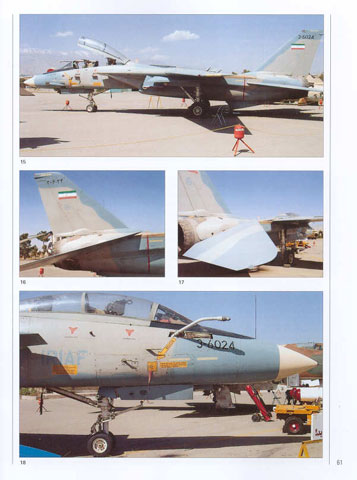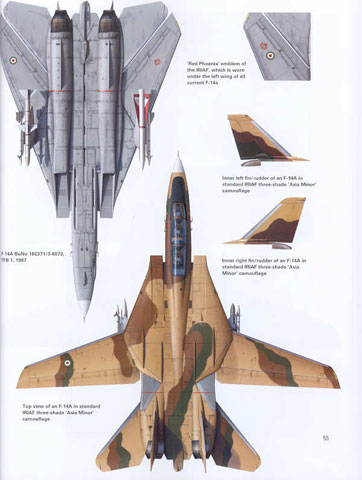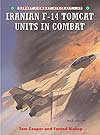S u m m a r y\
|
| Publisher and
Catalogue Details: |
Osprey Combat Aircraft
No. 49
Iranian F-14 Tomcat Units in Combat by Tom Cooper and Farzad
Bishop |
| ISBN: |
1841768014 |
| Media and
Contents: |
Soft cover, 96 pages |
| Price: |
GBP£12.99 online from Osprey Publishing |
| Review Type: |
FirstRead |
| Advantages: |
Excellent coverage of
subject matter from the perspective of those involved. |
| Disadvantages: |
|
|
Recommendation: |
Highly Recommended
|
Reviewed by Ken Bowes

Osprey's Iranian F-14 Units in Combat
will be available online from Squadron.com
This latest volume in the Combat
Aircraft Series (which concentrates on one of the greatest aircraft in
aviation history, the technology behind it and the men who flew it) has
proved to be an extremely interesting read.
Number 49 in the series focuses
on the use of the F-14 Tomcat by the Air Force of Iran from delivery in
1977 to the end of the Iran-Iraq War in 1988.
 Authors
Tom Cooper and Farzad Bishop seem to be single handedly documenting the
Islamic Republic of Iran Air Force (IRIAF) record in this conflict with
a number of volumes now on the subject. Along the way they seek to
debunk many myths that have grown about surrounding the ability of the
Iranians to operate their high tech American equipment effectively in
combat against the Iraqis and their foreign sponsors. They have
previously written books for Osprey including a volume on Osprey’s
Iranian F-4 Phantom II Units in Combat (No 37), whilst Tom Cooper has
also co-authored a volume on Arab used of the MiG-19 and MiG-21. Regular
users of the net will also know of Tom’s website, the Air Combat
Information Group.
Authors
Tom Cooper and Farzad Bishop seem to be single handedly documenting the
Islamic Republic of Iran Air Force (IRIAF) record in this conflict with
a number of volumes now on the subject. Along the way they seek to
debunk many myths that have grown about surrounding the ability of the
Iranians to operate their high tech American equipment effectively in
combat against the Iraqis and their foreign sponsors. They have
previously written books for Osprey including a volume on Osprey’s
Iranian F-4 Phantom II Units in Combat (No 37), whilst Tom Cooper has
also co-authored a volume on Arab used of the MiG-19 and MiG-21. Regular
users of the net will also know of Tom’s website, the Air Combat
Information Group.
This book is nothing less than
comprehensive covering the selection process that lead to Iran
purchasing the F-14 in the days of the Shah to counter Soviet MiG-25
overflights, production of the aircraft (during which the Iranians
financially bailed out Grumman) and training of the Iranian Pilots.
Cooper and Bishop then move on to the real meat of the volume with
chapters dealing broadly with F-14 operations grouped chronologically
across eight years of war. The access to Iranian veterans both in and
outside of Iran and careful research of contemporary reporting ensures
that the subject is covered comprehensively. In many cases the authors
were able to get first hand accounts of major actions involving the
Tomcat, including daring missions escorting strikes into Mosul via
Turkish airspace and encounters over Kharq Island when the AIM-54
Phoenix missile was suspected of having destroyed three or four MiG-23s
flying in close formation with a single missile. It is clear from
accounts included that the Iranian pilots were well acquainted with
their mounts and sought to make the best use of the weapons systems in
defence of Iran, even if many were tainted as Shah’s Pilots in the eyes
of the new Fundamentalist regime.
 Cooper
and Bishop were not afraid to be critical in this volume. Whilst the
Tomcat proved highly effective in winning limited air superiority for
Iran at certain times during the war, it was not without limitations.
The authors highlight the difficulties with the TF30 engine performance,
which resulted in combat failures and aircraft losses in much the same
way as with the US Navy. Also they highlight the several cases of
friendly fire, when Tomcats were lost to Iranian I-HAWK SAMS due to poor
coordination. One success that is highlighted was Iranian industry’s
success in producing critical spares for the aircraft following the US
embargo. This enabled the IRIAF to keep upwards of 30 aircraft
operational during the war although at times this dropped to as low as
10.
Cooper
and Bishop were not afraid to be critical in this volume. Whilst the
Tomcat proved highly effective in winning limited air superiority for
Iran at certain times during the war, it was not without limitations.
The authors highlight the difficulties with the TF30 engine performance,
which resulted in combat failures and aircraft losses in much the same
way as with the US Navy. Also they highlight the several cases of
friendly fire, when Tomcats were lost to Iranian I-HAWK SAMS due to poor
coordination. One success that is highlighted was Iranian industry’s
success in producing critical spares for the aircraft following the US
embargo. This enabled the IRIAF to keep upwards of 30 aircraft
operational during the war although at times this dropped to as low as
10.
This book will appeal to those
with an interest in Middle East conflicts (as we all know the Gulf
Region remains topical today) and small air force aviation. "Facts and
figures" fans are well catered for with an appendix that lists all 159
kills attributed to the Tomcat in IRIAF service. The detail is excellent
with date, aircrew, unit, weapon and victim ID all provided where known.
Interestingly Cooper and Bishop cover in some detail the post war
analysis of performance by the Iranians. It is clear from this final
reckoning that ideology overcame reality as the Iranians themselves only
credit 30 kills to the Tomcat, part of a trend which saw some 70% of all
air to air kills reattributed to Islamic Republican Guard Corps GBAD
systems post war
As usual for Osprey Publications, 15 colour profiles fill the centre
pages, as well as two four view plates which show the original and post
mid-1990s colours schemes applied to the Tomcat. The two-tone grey
scheme adopted in the mid-1990s is particularly attractive but
unfortunately no colour call outs are provide for (unlike the Asia Minor
scheme). Of course they are not going to be FS colours but some
indications of matches would be welcomed by modellers. The 18 full
colour photos are an excellent addition and provide some of the clearest
shots of Iranian Tomcats I have seen. The majority of included
photographs are however small and mostly in black and white. Given the
obscure nature of the subject the range of photographs is, however,
impressive. The comment on the photographs should not put one off this
book, as it is an excellent way to add a human dimension the scale
models on the display shelves.
The book comprises 96 pages printed on glossy paper between cardboard
covers.
Highly Recommended.
Thanks to
Osprey Publishing for the review sample
Iranian F-14 Tomcat Units in Combat
(Combat
Aircraft No. 49) |

|
| |
 |
Author:
Tom Cooper and Farzad Bishop
Illustrator: Chris Davey
US Price: $19.95
UK Price: £12.99
Publisher:
Osprey Publishing
Publish Date: September 23, 2004
Details: 96 pages; ISBN:
1841767875 |
|
|
Review Copyright © 2004 by
Ken Bowes
Page Created 25 May, 2004
Last updated 25 May, 2004
Back to
HyperScale Main Page
Home | What's
New | Features
| Gallery |
Reviews | Reference
| Forum
| Search